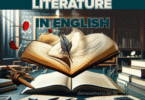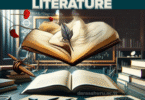LITERARY DEVICES (LANGUAGE DEVICES)
A literary device refers to artistic language structures used by writers to give a deeper meaning and flavor to their literary works. They include figures of speech and musical or sound techniques like rhyming scheme, alliteration etc.
A figure of speech is an expression of things that deviated from ordinary language. Figures of speech make literary works appear colorful and attractive to read.
Roles of literary devices in literature
- They sake for Example, metaphor and simile.
- They sake for Example, reiteration or repetition.
- They sake for clarity
- They sake for freshness
- They differentiate literary works from other works
- They sake for beauty
The most common literary devices used in literature
a) Metaphor
It is a figure of speech that makes a direct comparison between two unlike things without using the words “like or as”. It suggests that one thing is another thing or is equal to another thing. Example;
- He was a lion
- The lord is my shepherd
b) Simile
It is a figure of speech that makes a comparison between two unlike things by using the words “like”, “as”, “than” or “resembles”. Example;
- As white as snow
- Life is just like ice-cream, enjoy it before it melts
c) Irony
Is the use of words in such a way that the intended meaning is completely opposite to their literal meaning. It can happen or used intentionally or unintentionally to make the audience think about what has just been said or to emphasize a certain idea. Example;
- Bread is soft as a stone
- A bank lends you money provided you show that it is not
Types of irony
There are three types of ironies;
i. Verbal irony
Is the type of irony in which words are used to suggest the opposite of their usual meaning. It occurs when the intended meaning of the statement or works is different (often the opposite of) what the statement or work literary says.
For example Ibsen’s An Enemy of the People is ironically used since Dr. Stockman who is the declared an enemy, is in really sense and is a friend of the people. Example; ‘the bread is soft as a stone’.
ii. Dramatic irony
Is a failure of a character to see or understand what is obvious to the audience. Also, refers to a contradiction in a play between what a character thinks and what the reader or audience knows to be true.
Dramatic irony is the moment when the narrator and the audience share the knowledge or experience that a character is ignorant of it. Example, ‘in Oedipus the King by Sophocles where Oedipus fails to realize what the audience knows that he marries his mother’.
iii. Situation irony
It occurs when what happens is contrary to what is expected; or the actual outcome of a situation is the opposite of what is expected. Example;
- The son of the English teacher fails English
- The daughter of a rich merchant is expelled from school for lack of school fees of 20,000shs
d) Satire
Is a literary technique which principally ridicules its subject which includes individuals, organization, or states often as an intended means of provoking or preventing changes. It is a piece of writing that uses devices such as irony.
e) Sarcasm
Is a bitter cutting speech intended to wound someone’s feelings. It is intended by a speaker to give pain to a person addressed. Example,
STUDENT: I don’t understand TEACHER: Well I wouldn’t expect you too
f) Personification
Is the representation of inanimate objects or abstract ideas as living beings. It connects readers with the object that is personified. Example; The mountains cried, the valleys wept, and hills waited all mourning the death of Nyerere.
g) Apostrophe
Is a direct address to the dead or an inanimate object creating an emotional surge. Example;
- Nyerere, only if you were alive
- O heart of man-made God
h) Rhetorical question
Is the act of asking questions not to gain information but just for emphasis. No answer in fact is expected by the speaker. Example;
- Did you help me when I needed help?
- Did you once offer to intercede in my behalf?
- Did you do anything to listen my lord?
i) Hyperbole/overstatement
Is a figure of speech in which the truth is exaggerated for emphasis or for humorous effect. Example;
- I am so hungry that I can eat a whole
- She wept and wept until there was a sea of
j) Litotes/understatement
Is the use of a negative or weak statement to emphasize a positive meaning. Or is a figure of speech that uses an understated statement of an affirmative by using a negative description. Example;
- I was not feeling unhappy – I was happy
- I am not unmindful – I mind
k) Euphemism
Is a figure of speech which avoids the use of taboo or unpleasant words. Example;
- Rest room for toilet
- Pass away for die
- Hole for virgin
- 1,200 for penis
l) Metonymy
Is the substitution of a word with another word that is close related to it. It is a figure of speech that associates the name of one thing with that of something with that of something else. Example;
- Crown for king/government ruled by a king
- We waited hopelessly for two sunsets. Sunsets implies two days
- He has good name. Name refers to reputation
m) Synecdoche
Is a figure of speech in which the whole is represented by a part or a part by the whole. Example;
- He has several mouths to Mouths represent people
- The best brains in the Brains represent intellectually brilliant persons
- 50 head of Head represents whole animal
n) Onomatopoeia
Is the use of words which imitate the natural sounds of objects or things. Example;
- The humming bee
- The cackling hen
- The whizzing arrow
- The buzzing saw
- The hissing snake
- The splashing water
- The bang of a door
o) Climax
Is the arrangement of ideas in an increasing order of their importance. It is the arrangement of words, clauses or sentences in the order of their importance. Example;
- He came, he saw, he conquered her village, her state, her nation were her pride
- Eat, drink and sleep
p) Imagery
Is a figure of speech which creates mental pictures that appeal to readers’ five senses. Writers use sensory details to make readers imagine how things look/feel/smell/sound and test.
Types of imagery
Visual image: this means an image of Example,
- greater than the rift-valley
Organic image: this is an image of Example,
- More painful than the
Auditory image: this is an image of Example,
- I plead the cry of the
- The scream of a
Kinesthetic -This is an image of motion. Example,
- It is faster than camera
Tactile image: this is an image of Example,
- Standing hard and ready
Olfactory image: this is an image of Example,
- A stinking room.
Gustatory image: this is an image of Example,
- In search of sweetness.
LITERARY DEVICES (LANGUAGE DEVICES)

q) Anadiplosis
Is the repetition in which the last expression of one statement becomes the first expression in the following statement. Example, as in the poem “AFRICA” by David Diop,
The blood of your sweat, The sweat of your work, The work of your slavery,
The slavery of your children.
r) Symbolism
Is a literary device that uses one object to stand for something else or to mean something else. Example;
- Washing hands; to indicate non-environment
- Crown; to mean superiority
- Sunrise; to symbolize the beginning of the struggle
s) Pun
It is a humorous play on two or more meaning of the same word or on two different words with the same sound. Example;
“When my love swears that she is made of truth”. He says; therefore, I lie with her and she with me”
t) Allegory
Is a form of extended metaphor in which objects, persons and actions in a narrative are equated with the meanings that lie outside the narrative itself. Thus, an allegory is a story with two levels of meanings; a literal meaning and a symbolic meaning. Example,
George Orwell’s ANIMAL FARM which on the surface level is about a group of animals which take over their farm but on the deeper level is an allegory of the Russian revolution and the short comings of the communisms.
u) Anastrophe/inversion
Is a sentence or a poetic expression which reverses or changes the order of words for greater emphasis. Example,
- Ten thousand saw I at a glance – I saw ten thousand at a
- And away they go – and they go
v) Anaphora
This is the repetition of the word at the beginning of consecutive lines, verses or sentences. Example,
- The word “Africa” in the first three lines of the poem AFRICA by David Diop;
Africa of proud warriors in ancestral savannahs Africa of whom my grandmother sings.
w) Oxymoron
Is a figure of speech which includes words/phrases/ideas opposite in meaning placed one after the other. These are words which contradict itself. It combines two contradictory words. Example,
- True lie
- Silent noise
- Light darkness
x) Paradox
Is a figure of speech which includes a statement or sentence which contradict itself. Example,
- They have been burning us with a cold fire
- Look at those walking corpses
y) Suspense
Is a lack of certainty on the part of a concerned reader/audience about what is going to happen to character with which the reader has established a bond of sympathy. It is a feeling of worry or excitement that you have when you feel that something is going to happen.
z) Taboo words
These are words which have prohibited to be used in normal or public speech. It is also known as dysphemism. Example,
- Uncircumcised baboon
- Penis/vagina
- Rotten penis
aa) Allusion
Is a reference made by a writer in a literary work to a person, place or book without explicit identification. Example,
- Reference from holy books
Types of allusion
- Historical allusion
- Biblical allusion
bb)Antithesis
Is a literary technique in which the opposite or contrasting statements are balanced for emphasis. Example;
- Man proposes, God disposes
- Speech is silver, but silence is golden



